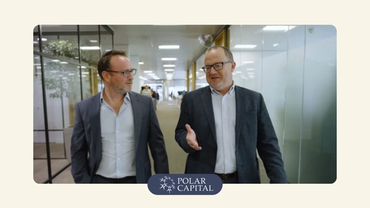Is Healthcare the Smart Complement to Tech?
Sector Hits 30% Discount as Catalysts Align
By Boring Money
11 Nov, 2025
This section is a paid promotion created in partnership with Polar Capital. The views and information presented reflect the sponsor’s messaging and may not represent the independent opinions of Boring Money. While we aim to ensure accuracy and relevance, this content should not be considered impartial advice.
The “diversification trade” is increasingly taking hold. While AI may look unstoppable, investors have started to worry over high valuations and speculative investments. However, they are still debating the best place to put their capital away from technology. With low valuations and long-term structural support, healthcare may be a natural choice.

The healthcare sector has been significantly out of favour and its relative valuation has dropped to multi-year lows across the market-cap spectrum.[1] Low valuation by itself is unlikely to draw investors back to the sector, but Gareth Powell, manager on the Polar Capital Global Healthcare trust, argues that the sector may be at an inflection point.
Four US Political Headwinds Begin to Clear
The sector has had to contend with four main near-term concerns, all related to the US administration. The first was the impact of Elon Musk’s ill-fated DOGE cuts on the various healthcare agencies. Investors worried that the cuts would be carelessly executed and disrupt healthcare practice in the US. There was undoubtedly disruption, but this has now stabilised with the relevant agencies continuing to function effectively.
The second was the impact of Robert F Kennedy Junior as health secretary. RFK Jr’s eccentric views on healthcare, including vaccine scepticism, created concerns over his stewardship of the Food and Drugs Administration (FDA). Powell says:
We’re now seeing the FDA run very well. It is under new leadership and there are efforts to accelerate the review of new products that have been filed.
He points out that new drug approvals are picking up and the backlog is clearing.
Another major concern has been tariffs. Donald Trump left it late to announce pharmaceutical tariffs, which let speculation run riot. In the end, they have come in broadly in line with expectations and resolved a key point of uncertainty for the sector.
Just one real issue remains: concerns over drug pricing in the US. The US is the largest market for almost all pharmaceutical companies, and the commitment from Donald Trump to drive down drugs pricing sparked fear across the sector. However, there are green shoots here as well. The US administration has created bespoke agreements with specific drugs groups such as Pfizer and AstraZeneca on pricing.
If you look at the number of 75 year olds and the rate at which that number is growing, it could be a powerful driver for the healthcare sector. Over the lifespan of a human, healthcare utilisation really starts to rise between 70 and 75.
It is also worth noting that healthcare has historically performed better in the second year of a US presidential term when the risks of radical policy are reduced. This is particularly the case if the mid-terms flip the balance of power in Congress.
Aging Population Creates Powerful Long-Term Growth Driver
With more clarity on these short-term challenges, investors may start to focus on the longer-term strengths of the healthcare sector. One of the most compelling long-term arguments for the sector is that it is on the right side of demographic trends. The World Health Organization points out that by 2030, 1 in 6 people in the world will be aged 60 years or over. At the same time, the share of the population aged 60 years and over will increase from 1 billion in 2020 to 1.4 billion.[2] Healthy life expectancy has often not kept up with broader life expectancy, and demand for healthcare continues to increase.
This may give investors some hope that all of these overhangs have now been dealt with, and it leaves a clearer path for the healthcare sector to do much better.
There is a second, often overlooked, driver for healthcare companies: emerging markets. In its report into the sector, Morgan Stanley writes:
As per capita wealth increases in countries such as China and India, healthcare spending is growing.[4] China’s total health expenditure as a percentage of GDP has increased from 5.22% to 7.05%. This exceeds the WHO’s recommendation for medium-low income countries of 5–7%.
Healthcare Valuations Spark M&A Activity
Healthcare valuations are unquestionably cheap. The MSCI World Healthcare index has risen just 7.5% for the year to date, compared to 20.2% for the MSCI World index.[5] This has continued to widen the valuation gap between healthcare and the rest of the market. The forward price-to-earnings ratio for the sector now sits at 16.8x, compared to 20.6x for the broader index.
Relative price to earnings levels are sitting at a 30% discount to the market. Small and mid caps are particularly attractive, where relative valuations are at their lowest level since the 1980s.
He also points out that a number of other contrarian indicators are flashing green: ETF flows have been at rock bottom since late 2024, while the healthcare weighting in the S&P 500 is at levels not seen since 1993/4 (also a moment when investors were very fearful of what might happen to healthcare in the US).
Perhaps more importantly, says Douglas, earnings revisions have been rising since the start of the year. He says this has been a leading indicator for better performance.
The sector has continued to plough ahead on revenues and earnings.
Cheap valuations and rising earnings have been noticed by corporate buyers. Merger and acquisition activity has started to pick up in the sector. Earlier this month, Swiss pharmaceutical group Novartis agreed to buy rare disease-focused biotech Avidity Bioscience at a value of $11bn.[6] Earlier this year, it also bought cardiovascular biotechs Tourmaline Bio and Anthos Therapeutics for $1.4bn and $3.1bn, respectively.
In early January, Johnson & Johnson announced a $14.6bn acquisition of Intra-Cellular Therapies[7]. There have also been healthcare deals outside the pharmaceutical sector. In an update, PwC says:
Innovation Pipeline Strengthens Across Obesity, Oncology, and Diabetes
This all creates a more optimistic backdrop for the healthcare sector in the months ahead, even if perennial concerns, such as patent cliffs, remain. However, Powell points out that some of the strongest bull markets, such as those in the 1990s and after 2007 have come when there are new product cycles. This creates a story around the sector that investors can get behind.
80% of the investment universe is product companies, across pharma, biotech, medical devices, this is the way you make returns. What people need is real innovation in products. We’re seeing a vast array of new products today. The obesity drugs have been very topical, for example. We’re seeing it across the board. That’s not reflected in the stock market.
He says there are also significant developments in oncology:
There are a new range of biotech products, replicating the immune system. There are cell therapies that remove cells, treat them outside the body, reinject them and the cure rates in patients are amazing.” There is progress on a cure for Type 1 diabetes. “It’s these types of diseases, where patients have associated ‘events’ that push healthcare costs up - that’s why cost of managing chronic diseases is so high for the NHS.
He says another potential driver for the sector is the backlog on medical procedures created by Covid. This is creating an environment round the world where utilisation of healthcare is higher. He points to the NHS, where waiting lists have increased significantly and are still very high. This is a powerful driver for volume growth.
On the sector, he says, “It’s very diversified. It’s about individual stories. That’s the great thing about healthcare.”
If investors are hunting around for an alternative to the over-hyped technology sector, healthcare may be an option.
_____
[1] Poral Capital Healthcare Trust plc, October 2025
[2] WHO, October 2025
[3] Morgan Stanley
[4] Frontiers, September 2024
[5] MSCI World Healthcare Index
[6] Financial Times
[7] PwC, June 2025








